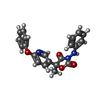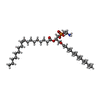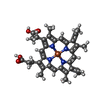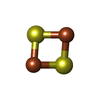+ Open data
Open data
- Basic information
Basic information
| Entry | Database: PDB / ID: 7tlj | ||||||
|---|---|---|---|---|---|---|---|
| Title | Rhodobacter sphaeroides Mitochondrial respiratory chain complex | ||||||
 Components Components |
| ||||||
 Keywords Keywords |  OXIDOREDUCTASE / OXIDOREDUCTASE /  Mitochondrial respiratory chain complex / Mitochondrial respiratory chain complex /  cytochrome bc1 / inhibitors / cytochrome bc1 / inhibitors /  electron transfer electron transfer | ||||||
| Function / homology |  Function and homology information Function and homology informationrespiratory chain complex III / quinol-cytochrome-c reductase /  ubiquinol-cytochrome-c reductase activity / ubiquinol-cytochrome-c reductase activity /  respirasome / respiratory electron transport chain / 2 iron, 2 sulfur cluster binding / respirasome / respiratory electron transport chain / 2 iron, 2 sulfur cluster binding /  electron transfer activity / electron transfer activity /  oxidoreductase activity / intracellular membrane-bounded organelle / oxidoreductase activity / intracellular membrane-bounded organelle /  heme binding ...respiratory chain complex III / quinol-cytochrome-c reductase / heme binding ...respiratory chain complex III / quinol-cytochrome-c reductase /  ubiquinol-cytochrome-c reductase activity / ubiquinol-cytochrome-c reductase activity /  respirasome / respiratory electron transport chain / 2 iron, 2 sulfur cluster binding / respirasome / respiratory electron transport chain / 2 iron, 2 sulfur cluster binding /  electron transfer activity / electron transfer activity /  oxidoreductase activity / intracellular membrane-bounded organelle / oxidoreductase activity / intracellular membrane-bounded organelle /  heme binding / heme binding /  metal ion binding / metal ion binding /  plasma membrane / plasma membrane /  cytoplasm cytoplasmSimilarity search - Function | ||||||
| Biological species |   Cereibacter sphaeroides (bacteria) Cereibacter sphaeroides (bacteria) | ||||||
| Method |  ELECTRON MICROSCOPY / ELECTRON MICROSCOPY /  single particle reconstruction / single particle reconstruction /  cryo EM / Resolution: 2.91 Å cryo EM / Resolution: 2.91 Å | ||||||
 Authors Authors | Xia, D. / Zhou, F. / Esser, L. / Huang, R. | ||||||
| Funding support |  United States, 1items United States, 1items
| ||||||
 Citation Citation |  Journal: to be published Journal: to be publishedTitle: Conformation Switch of Rieske ISP subunit is revealed by the Crystal Structure of Bacterial Cytochrome bc1 in Complex with Azoxystrobin Authors: Xia, D. / Esser, L. / Zhou, F. | ||||||
| History |
|
- Structure visualization
Structure visualization
| Structure viewer | Molecule:  Molmil Molmil Jmol/JSmol Jmol/JSmol |
|---|
- Downloads & links
Downloads & links
- Download
Download
| PDBx/mmCIF format |  7tlj.cif.gz 7tlj.cif.gz | 821.8 KB | Display |  PDBx/mmCIF format PDBx/mmCIF format |
|---|---|---|---|---|
| PDB format |  pdb7tlj.ent.gz pdb7tlj.ent.gz | 554.3 KB | Display |  PDB format PDB format |
| PDBx/mmJSON format |  7tlj.json.gz 7tlj.json.gz | Tree view |  PDBx/mmJSON format PDBx/mmJSON format | |
| Others |  Other downloads Other downloads |
-Validation report
| Arichive directory |  https://data.pdbj.org/pub/pdb/validation_reports/tl/7tlj https://data.pdbj.org/pub/pdb/validation_reports/tl/7tlj ftp://data.pdbj.org/pub/pdb/validation_reports/tl/7tlj ftp://data.pdbj.org/pub/pdb/validation_reports/tl/7tlj | HTTPS FTP |
|---|
-Related structure data
| Related structure data |  25989MC  7tayC M: map data used to model this data C: citing same article ( |
|---|---|
| Similar structure data | Similarity search - Function & homology  F&H Search F&H Search |
- Links
Links
- Assembly
Assembly
| Deposited unit | 
|
|---|---|
| 1 |
|
- Components
Components
-Protein , 4 types, 8 molecules AEBFCGDH
| #1: Protein |  Mass: 50087.422 Da / Num. of mol.: 2 / Source method: isolated from a natural source / Source: (natural)   Cereibacter sphaeroides (bacteria) / References: UniProt: Q02761 Cereibacter sphaeroides (bacteria) / References: UniProt: Q02761#2: Protein |  Mass: 29589.158 Da / Num. of mol.: 2 Source method: isolated from a genetically manipulated source Details: Cyt c1 with c-terminal hexa his tag / Source: (gene. exp.)   Cereibacter sphaeroides (bacteria) / Gene: petC, fbcC / Production host: Cereibacter sphaeroides (bacteria) / Gene: petC, fbcC / Production host:   Escherichia coli (E. coli) / References: UniProt: Q02760 Escherichia coli (E. coli) / References: UniProt: Q02760#3: Protein | Mass: 19928.375 Da / Num. of mol.: 2 / Source method: isolated from a natural source / Source: (natural)   Cereibacter sphaeroides (bacteria) / References: UniProt: Q02762, quinol-cytochrome-c reductase Cereibacter sphaeroides (bacteria) / References: UniProt: Q02762, quinol-cytochrome-c reductase#4: Protein | Mass: 14415.301 Da / Num. of mol.: 2 / Source method: isolated from a natural source Details: This is the natural subunit IV. Only one helix could be determined. Subunit IV has turned out to be rather elusive in numerous crystal structures - it was never determined i.e. got lost ...Details: This is the natural subunit IV. Only one helix could be determined. Subunit IV has turned out to be rather elusive in numerous crystal structures - it was never determined i.e. got lost during crystallization. Here in our CryoEM structure we see it for the first time - even though only one helix Source: (natural)   Cereibacter sphaeroides (bacteria) / References: UniProt: P16536 Cereibacter sphaeroides (bacteria) / References: UniProt: P16536 |
|---|
-Non-polymers , 5 types, 12 molecules 








| #5: Chemical | ChemComp-HEM /  Heme B Heme B#6: Chemical | #7: Chemical | #8: Chemical |  Heme C Heme C#9: Chemical |  Iron–sulfur cluster Iron–sulfur cluster |
|---|
-Details
| Has ligand of interest | Y |
|---|
-Experimental details
-Experiment
| Experiment | Method:  ELECTRON MICROSCOPY ELECTRON MICROSCOPY |
|---|---|
| EM experiment | Aggregation state: PARTICLE / 3D reconstruction method:  single particle reconstruction single particle reconstruction |
- Sample preparation
Sample preparation
| Component | Name: Cytochrome bc1 complex of rhodobacter sphaeroides inhibited by pyramoxadone Type: COMPLEX / Entity ID: #1-#4 / Source: NATURAL | |||||||||||||||||||||||||
|---|---|---|---|---|---|---|---|---|---|---|---|---|---|---|---|---|---|---|---|---|---|---|---|---|---|---|
| Molecular weight | Value: 250 kDa/nm / Experimental value: NO | |||||||||||||||||||||||||
| Source (natural) | Organism:   Cereibacter sphaeroides (bacteria) Cereibacter sphaeroides (bacteria) | |||||||||||||||||||||||||
| Source (recombinant) | Organism:   Escherichia coli (E. coli) Escherichia coli (E. coli) | |||||||||||||||||||||||||
| Buffer solution | pH: 7.5 | |||||||||||||||||||||||||
| Buffer component |
| |||||||||||||||||||||||||
| Specimen | Conc.: 8 mg/ml / Embedding applied: NO / Shadowing applied: NO / Staining applied : NO / Vitrification applied : NO / Vitrification applied : YES : YESDetails: Cytochrome bc1 complex from Rhodobacter sphaeroides with inhibitor pyramoxadone (PQ4), frozen stock 84 mg/ml. dilute to 8 mg/ml in buffer 50mM TrisHCl, pH7.5/0.16% SMC/0.01% GDN/1mM EDTA | |||||||||||||||||||||||||
| Specimen support | Grid material: COPPER / Grid mesh size: 400 divisions/in. / Grid type: Quantifoil R1.2/1.3 | |||||||||||||||||||||||||
Vitrification | Instrument: FEI VITROBOT MARK IV / Cryogen name: ETHANE / Humidity: 95 % / Chamber temperature: 277 K Details: 3 ul of sample blot for 3 sec. blot force 20. glow discharge for 60 sec with easy glow |
- Electron microscopy imaging
Electron microscopy imaging
| Experimental equipment |  Model: Titan Krios / Image courtesy: FEI Company |
|---|---|
| Microscopy | Model: FEI TITAN KRIOS |
| Electron gun | Electron source : :  FIELD EMISSION GUN / Accelerating voltage: 300 kV / Illumination mode: FLOOD BEAM FIELD EMISSION GUN / Accelerating voltage: 300 kV / Illumination mode: FLOOD BEAM |
| Electron lens | Mode: BRIGHT FIELD Bright-field microscopy / Nominal magnification: 105000 X / Calibrated magnification: 60241 X / Nominal defocus max: 2500 nm / Nominal defocus min: 1000 nm / Calibrated defocus min: 836 nm / Calibrated defocus max: 3434 nm / Cs Bright-field microscopy / Nominal magnification: 105000 X / Calibrated magnification: 60241 X / Nominal defocus max: 2500 nm / Nominal defocus min: 1000 nm / Calibrated defocus min: 836 nm / Calibrated defocus max: 3434 nm / Cs : 2.7 mm / C2 aperture diameter: 100 µm / Alignment procedure: COMA FREE : 2.7 mm / C2 aperture diameter: 100 µm / Alignment procedure: COMA FREE |
| Specimen holder | Cryogen: NITROGEN / Specimen holder model: FEI TITAN KRIOS AUTOGRID HOLDER / Temperature (max): 80 K / Temperature (min): 80 K |
| Image recording | Average exposure time: 2.5 sec. / Electron dose: 54.5 e/Å2 / Film or detector model: GATAN K3 BIOQUANTUM (6k x 4k) / Num. of grids imaged: 2 / Num. of real images: 20306 / Details: 0.05s per frame for total 50 frames. |
| EM imaging optics | Energyfilter name : GIF Bioquantum / Energyfilter slit width: 20 eV : GIF Bioquantum / Energyfilter slit width: 20 eV |
| Image scans | Sampling size: 5 µm / Width: 4092 / Height: 5760 |
- Processing
Processing
| Software |
| |||||||||||||||||||||||||||||||||||||||||||||
|---|---|---|---|---|---|---|---|---|---|---|---|---|---|---|---|---|---|---|---|---|---|---|---|---|---|---|---|---|---|---|---|---|---|---|---|---|---|---|---|---|---|---|---|---|---|---|
| EM software |
| |||||||||||||||||||||||||||||||||||||||||||||
CTF correction | Type: PHASE FLIPPING AND AMPLITUDE CORRECTION | |||||||||||||||||||||||||||||||||||||||||||||
| Particle selection | Num. of particles selected: 5498641 | |||||||||||||||||||||||||||||||||||||||||||||
| Symmetry | Point symmetry : C2 (2 fold cyclic : C2 (2 fold cyclic ) ) | |||||||||||||||||||||||||||||||||||||||||||||
3D reconstruction | Resolution: 2.91 Å / Resolution method: FSC 0.143 CUT-OFF / Num. of particles: 725256 / Num. of class averages: 2 / Symmetry type: POINT | |||||||||||||||||||||||||||||||||||||||||||||
| Refinement | Cross valid method: NONE Stereochemistry target values: GeoStd + Monomer Library + CDL v1.2 | |||||||||||||||||||||||||||||||||||||||||||||
| Displacement parameters | Biso mean: 56.36 Å2 | |||||||||||||||||||||||||||||||||||||||||||||
| Refine LS restraints |
|
 Movie
Movie Controller
Controller



 PDBj
PDBj


















